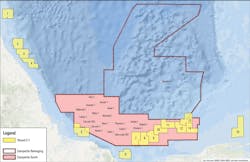Schlumberger WesternGeco grabs GoM wins
Schlumberger WesternGeco grabs GoM wins
Schlumberger WesternGeco recently secured two big wins in the Gulf of Mexico. The news follows August’s announcement that Schlumberger and TGS had started the full-azimuth multi-client Revolution XII and XIII surveys, covering about 7,150 sq km (2,761 sq mi) in the Green Canyon, Atwater Valley, and Ewing Bank protraction areas of the central Gulf of Mexico.
Schlumberger and ION Geophysical Corp. announced a new 3D multi-client reimaging broadband program offshore Mexico, which uses the country’s National Hydrocarbons Commission data library.
The Campeche 3D reimaging program comprises three survey areas covering approximately 82,000 sq km (31,660 sq mi) in the Bay of Campeche offshore southern Mexico.
The program will be processed using a combination of custom technologies and techniques from both organizations with the aim of informing for upcoming licensing rounds.
Schlumberger WesternGeco says that the complexity and variability of the geological areas being surveyed require a set of consistent, advanced workflows to maximize bandwidth, while producing data with strong, low-frequency content for subsalt areas and high-resolution data for non-salt areas of the basin.
The use of broadband preprocessing coupled with high-resolution steep dip reverse time migration and Kirchhoff imaging algorithms will produce data for prospect identification and exploration.
The program is fully supported by industry funding. Fasttrack data is available now for Round 1.4 deepwater bid preparation decisions.
In addition, Schlumberger and Petronas (E&P) Overseas Ventures have signed an agreement to license a significant part of the WesternGeco Campeche wide-azimuth (WAZ) deepwater multi-client seismic survey in the southern Gulf of Mexico.
“Petronas is looking for high-quality global growth opportunities and we plan to use the best available technology to focus our search for these opportunities,” said Emeliana Rice-Oxley, vice president of Exploration, Petronas. “The WAZ seismic will help unravel the hydrocarbon potential in the complex and under explored Mexican deepwater basins. This agreement is a step towards achieving our growth strategy and demonstrates our long-term commitment to exploration in Mexico. This will enable Petronas’ growth efforts in high grading selective new investments to strategically position ourselves and grow in the region, in support of Mexico’s energy reform. In addition to the Gulf of Mexico, Petronas also has a sizeable library of multi-client seismic data covering the southern Atlantic Margin, which is also part of our exploration focus area.”
The WesternGeco Campeche WAZ deepwater multi-client seismic survey is located in the southern Gulf of Mexico. More than 80,000 sq km (30,888 sq mi) of newly imaged subsurface data, which has been acquired in the last 12 months, is available for oil and gas companies participating in exploration in Mexico. The project follows the Mexican government’s opening of licensing rounds to non-government companies for the first time.
September proves big for Spectrum
With only one day between announcements, Spectrum Geo proposed a survey offshore Africa and then began acquisition work in the western Barents Sea.
The company was awarded Tender Area 2, which covers the southern Rovuma and northeastern Zambezi basins offshore Mozambique. It proposed to undertake a comprehensive long-offset broadband 2D multi-client seismic survey with a variable grid with lines spaced from 10 to 20 km (6 to 12 mi), totaling in excess of 16,000 km (9,942 mi).
The new seismic data will image the subsurface potential in open areas of the southern Rovuma basin and the western flanks of the Kerimbas Graben, west of the Davie Fracture Zone, revealing the prospectivity in this region for what Spectrum says will be the first time.
Potential targets along the Mozambique margin have already been identified in both structural and stratigraphic settings. These include Cretaceous and Tertiary turbidites and buried canyon plays. The survey will also aim to image the syn-rift structures and Late Cretaceous pro-delta stacked turbidite sequences in the northeast Zambezi Depression. The Zambezi Delta exhibits complex structuration following extensive recent compressional tectonics. Several potential source, reservoir, and seal intervals have already been identified in this area. Play types include onlaps and drapes over basement highs, stratigraphic and structural traps of deepwater slope channel and basin floor fan complexes, lowstand plays (both wedge and pro-delta fan), syn-rift graben hanging wall and footwall plays, and strike slip structural plays.
New 2D data will play a role in understanding the hydrocarbon potential of the area and accelerate exploration activity in what is believed to be an oil-dominated region offshore Mozambique, Spectrum says.
On partnership with BGP, Spectrum has also begun acquisition of a 1,800-sq km (695-sq mi) multi-client 3D seismic survey offshore Norway in the western Barents Sea. The new survey, designed based on interest from industry, will tie and complement Spectrum’s existing 3D surveys in the area. When completed, the combined coverage will total about 20,000 sq km (7,722 sq mi) over prospective and potential 24th Norwegian licensing round in 2017.
Data is being acquired with 10-by-8,000-m (33-by-26,246 ft) streamer offsets to record data necessary to understand the basins architecture and to better image the prospective zones within the Palaeocene-Eocene and Jurassic-Cretaceous as well as the Late Cretaceous marine sands. The data will be processed by Spectrum and a broadband fasttrack volume will be available in 1Q 2017. The final PreSTM broadband dataset and offset volumes will be available in 2Q 2017, ahead of the licensing round. •


